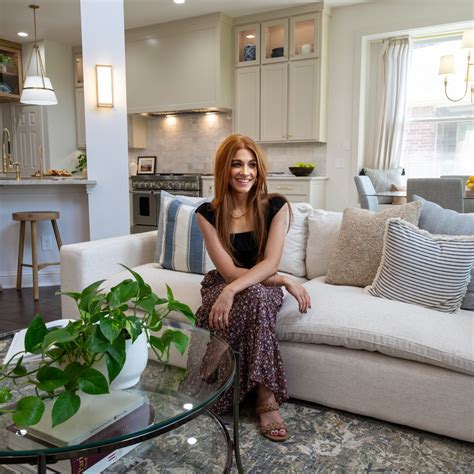
Outdated home decor trends are cramping your style? HGTV’s Jenn Todryk, the renovation expert from “No Demo Reno,” advises homeowners to ditch overly-themed rooms, furniture sets, and faux plants to create a more modern and personalized living space.
Jenn Todryk, known for her practical and budget-friendly renovation solutions on HGTV’s “No Demo Reno,” is urging homeowners to reconsider some common design choices that she believes have become outdated. In a recent interview, Todryk highlighted three specific trends that she suggests phasing out: overly-themed rooms, matching furniture sets, and artificial plants. According to Todryk, moving away from these design elements can help create a more contemporary, unique, and inviting home environment.
Todryk’s recommendations stem from her experience in transforming homes without extensive demolition, focusing instead on cosmetic changes and smart design choices. Her approach resonates with many homeowners who want to update their spaces without incurring significant costs or disruptions. By identifying these outdated trends, Todryk provides a starting point for individuals looking to refresh their homes and reflect their personal style more effectively.
The Problem with Overly-Themed Rooms
One of Todryk’s primary concerns is the tendency to design rooms around a single, dominant theme. She argues that while thematic designs might seem appealing initially, they often lack depth and can quickly become stale. “When everything in a room screams a specific theme, it can feel forced and inauthentic,” Todryk explains. “Your home should reflect your personality and evolving tastes, not a static idea.”
Overly-themed rooms often involve a rigid adherence to specific colors, patterns, and accessories, leaving little room for individuality or creativity. For instance, a “nautical-themed” bathroom might include seashells, anchors, and blue-and-white stripes throughout, creating a predictable and somewhat cliché aesthetic. Similarly, a “safari-themed” living room could feature animal prints, tribal masks, and earth-toned furniture, resulting in a space that feels more like a stage set than a comfortable living area.
Todryk suggests moving away from such rigid themes and instead focusing on creating a cohesive and eclectic mix of elements. This approach allows homeowners to incorporate pieces that they genuinely love, regardless of whether they fit neatly into a predefined theme. By blending different styles, textures, and colors, it’s possible to create a space that feels more personal, dynamic, and timeless.
To avoid the pitfalls of overly-themed rooms, Todryk recommends starting with a neutral foundation and gradually adding layers of interest through artwork, textiles, and accessories. This approach provides greater flexibility and allows for easier updates as tastes evolve. For example, instead of committing to a fully nautical-themed bathroom, one could incorporate subtle nautical elements, such as a vintage ship print or a rope mirror, while maintaining a clean and modern overall aesthetic.
Furthermore, Todryk emphasizes the importance of incorporating personal touches that reflect the homeowner’s interests and experiences. “Your home should tell a story,” she says. “Include pieces that have meaning to you, whether it’s a travel souvenir, a family heirloom, or a piece of art that you love.” These personal elements add character and depth to a space, making it feel more authentic and lived-in.
Ultimately, Todryk’s advice is to embrace individuality and create a home that reflects one’s unique personality and style. By moving away from rigid themes and focusing on creating a cohesive and eclectic mix of elements, homeowners can achieve a more timeless and inviting living space.
The Downfall of Matching Furniture Sets
Another trend that Todryk advises against is the use of matching furniture sets. While these sets might seem convenient and coordinated, she argues that they often lack character and can make a room feel generic and impersonal. “Matching furniture sets can make a room feel like it came straight out of a catalog,” Todryk notes. “They lack the individuality and charm that come from curating pieces over time.”
Matching furniture sets typically include a sofa, loveseat, and armchair in the same style, fabric, and color, often accompanied by matching coffee tables and end tables. While this approach ensures a consistent look, it can also result in a space that feels monotonous and predictable. The lack of visual contrast and variety can make a room feel flat and uninspired.
Todryk suggests breaking up matching furniture sets and instead opting for a more eclectic mix of pieces. This approach allows homeowners to create a space that feels more unique, dynamic, and reflective of their personal style. By combining different styles, textures, and colors, it’s possible to create a more visually interesting and inviting room.
To create a cohesive yet eclectic look, Todryk recommends starting with a focal point, such as a statement sofa or a unique coffee table. From there, one can gradually add other pieces that complement the focal point, while also introducing elements of contrast and variety. For example, instead of purchasing a matching loveseat and armchair, one could opt for a different style of armchair or a pair of accent chairs in a complementary color or pattern.
Furthermore, Todryk emphasizes the importance of incorporating vintage or antique pieces into the mix. “Vintage and antique pieces add character and history to a space,” she says. “They can also serve as conversation starters and add a sense of uniqueness to your home.” By incorporating these pieces, homeowners can create a space that feels more personal, authentic, and timeless.
In addition to mixing styles, Todryk also recommends playing with different textures and colors. Combining smooth and rough textures, or pairing warm and cool colors, can add depth and visual interest to a room. For example, one could pair a velvet sofa with a woven rug and a leather armchair, or combine a gray sofa with pops of color in the form of throw pillows and artwork.
Ultimately, Todryk’s advice is to embrace individuality and create a home that reflects one’s unique personality and style. By moving away from matching furniture sets and opting for a more eclectic mix of pieces, homeowners can achieve a more dynamic, inviting, and personalized living space.
The Case Against Faux Plants
The final trend that Todryk advises homeowners to reconsider is the use of artificial plants. While faux plants might seem like a low-maintenance way to add greenery to a space, she argues that they often look cheap and unconvincing. “Faux plants can often look dated and unnatural,” Todryk explains. “They lack the vibrancy and life that real plants bring to a room.”
Artificial plants have become increasingly popular in recent years, particularly among individuals who lack the time or inclination to care for real plants. However, Todryk believes that the visual impact of faux plants often falls short of expectations. She argues that the plastic or silk materials used to create artificial plants can look cheap and unrealistic, especially when compared to the real thing.
Furthermore, Todryk points out that artificial plants lack the air-purifying benefits and psychological benefits of real plants. Real plants help to improve indoor air quality by absorbing carbon dioxide and releasing oxygen, while also reducing stress and promoting a sense of well-being. These benefits are absent in artificial plants, making them a less desirable option for creating a healthy and inviting home environment.
Todryk suggests that homeowners who want to incorporate greenery into their homes should opt for real plants instead. Even if one lacks a green thumb, there are many low-maintenance plant species that are relatively easy to care for. Succulents, snake plants, and ZZ plants are all excellent choices for beginners, as they require minimal watering and can tolerate a wide range of growing conditions.
For individuals who are concerned about the maintenance requirements of real plants, Todryk recommends starting with a few small, easy-to-care-for plants and gradually expanding their collection as they become more comfortable with plant care. She also suggests using self-watering planters or hiring a professional plant care service to simplify the process.
In addition to real plants, Todryk also suggests incorporating other natural elements into the home, such as wood, stone, and natural fibers. These materials can add warmth, texture, and visual interest to a space, while also creating a connection to the natural world. For example, one could incorporate a wooden coffee table, a stone fireplace, or a woven rug into their living room to create a more inviting and organic feel.
Ultimately, Todryk’s advice is to embrace the beauty and vitality of nature and incorporate real plants into the home whenever possible. By avoiding artificial plants and opting for real greenery, homeowners can create a more vibrant, healthy, and inviting living space.
Creating a Timeless and Personalized Home
Jenn Todryk’s advice on avoiding overly-themed rooms, matching furniture sets, and faux plants underscores a broader philosophy about home design: that homes should be personalized reflections of the people who live in them. By moving away from these outdated trends, homeowners can create spaces that are more authentic, timeless, and inviting.
Todryk’s approach to home renovation emphasizes the importance of individuality and creativity. She encourages homeowners to embrace their unique tastes and preferences, and to incorporate pieces that they genuinely love into their homes. By doing so, it’s possible to create a space that feels personal, dynamic, and reflective of one’s unique personality and style.
In addition to embracing individuality, Todryk also emphasizes the importance of creating a cohesive and balanced design. This involves carefully considering the colors, textures, and styles that are used throughout the home, and ensuring that they work together harmoniously. By paying attention to these details, it’s possible to create a space that feels both visually appealing and comfortable to live in.
Todryk also advocates for a more sustainable and eco-friendly approach to home design. She encourages homeowners to choose durable, high-quality materials that will last for many years, and to repurpose or recycle existing items whenever possible. By adopting a more sustainable approach, it’s possible to create a home that is both beautiful and environmentally responsible.
Ultimately, Jenn Todryk’s advice is to create a home that is a reflection of oneself, embracing individuality, creativity, and sustainability. By moving away from outdated trends and focusing on creating a personalized and timeless design, homeowners can create a space that they truly love and enjoy for many years to come. Her no-demo approach provides attainable, budget-conscious ways for people to express themselves through their living spaces, making good design accessible for all.
Detailed Analysis of Each Trend
To better understand why Jenn Todryk recommends ditching these trends, let’s delve into a more detailed analysis of each one:
1. Overly-Themed Rooms: The Pitfalls of Thematic Design
The problem with overly-themed rooms goes beyond mere aesthetics. While a themed room might seem fun or unique at first, it often lacks longevity and can quickly become tiresome. Here’s a deeper look at the drawbacks:
-
Lack of Personalization: Thematic designs often prioritize the theme over the individual’s personal tastes and experiences. A room filled with generic nautical decorations, for example, might not reflect the homeowner’s actual connection to the sea or their personal history.
-
Limited Flexibility: Once a room is designed around a specific theme, it becomes difficult to update or change without completely redoing the space. As the homeowner’s tastes evolve, the themed room can feel increasingly outdated and irrelevant.
-
Risk of Cliché: Overly-themed rooms often rely on predictable and cliché elements, such as seashells in a bathroom or animal prints in a safari-themed room. These clichés can make the space feel unoriginal and uninspired.
-
Difficulty in Integration: Themed rooms can be difficult to integrate with the rest of the home, especially if the other rooms have different styles or themes. This can create a sense of disconnect and make the home feel disjointed.
-
Cost Considerations: Achieving a convincing themed room often requires purchasing a large number of themed decorations and accessories, which can be expensive. Moreover, the need to replace these items as the theme becomes outdated can add to the overall cost.
Instead of rigidly adhering to a theme, Todryk advocates for a more nuanced approach that incorporates subtle nods to the homeowner’s interests and passions. This can be achieved through the use of carefully chosen artwork, textiles, and accessories that complement the overall design without overwhelming the space.
Alternatives to Themed Rooms:
-
Eclectic Design: Combining different styles, textures, and colors to create a unique and personalized space.
-
Minimalist Design: Focusing on simplicity, functionality, and clean lines to create a calm and uncluttered environment.
-
Transitional Design: Blending traditional and contemporary elements to create a timeless and versatile space.
-
Biophilic Design: Incorporating natural elements, such as plants, wood, and stone, to create a connection to nature.
By embracing these alternative approaches, homeowners can create spaces that are more authentic, engaging, and reflective of their individual personalities.
2. Matching Furniture Sets: The Monotony of Coordination
Matching furniture sets have long been a popular choice for homeowners seeking a coordinated and hassle-free decorating solution. However, Todryk argues that these sets often lack character and can make a room feel generic and impersonal. Here’s a closer look at the drawbacks:
-
Lack of Individuality: Matching furniture sets create a uniform look that can feel sterile and impersonal. The absence of variety and contrast can make the room feel uninspired and lacking in personality.
-
Limited Creativity: Matching sets discourage creativity and experimentation, as the homeowner is limited to the pieces that are included in the set. This can stifle the design process and prevent the homeowner from expressing their unique style.
-
Difficult to Customize: Matching sets are often difficult to customize or personalize. The homeowner is limited to the colors, fabrics, and styles that are offered by the manufacturer, which can restrict their design options.
-
Higher Cost: Despite their perceived convenience, matching furniture sets can often be more expensive than purchasing individual pieces. This is because the manufacturer is able to charge a premium for the coordinated look.
-
Depreciation: Because matching sets are often trendy, they can quickly become outdated, leading to depreciation in value.
Instead of relying on matching furniture sets, Todryk encourages homeowners to curate their furniture pieces over time, selecting items that reflect their individual tastes and preferences. This approach allows for greater creativity and personalization, resulting in a space that feels more unique and inviting.
Alternatives to Matching Furniture Sets:
-
Mix-and-Match Design: Combining furniture pieces from different styles, periods, and manufacturers to create a unique and eclectic look.
-
Statement Pieces: Selecting a few key furniture pieces that stand out and serve as focal points in the room.
-
Vintage and Antique Furniture: Incorporating vintage and antique pieces to add character and history to the space.
-
Custom Furniture: Commissioning custom-made furniture pieces that are tailored to the homeowner’s specific needs and preferences.
By embracing these alternative approaches, homeowners can create spaces that are more dynamic, engaging, and reflective of their individual personalities.
3. Faux Plants: The Illusion of Greenery
Artificial plants have become a popular choice for homeowners seeking a low-maintenance way to add greenery to their homes. However, Todryk argues that these plants often look cheap and unconvincing, and lack the benefits of real plants. Here’s a closer look at the drawbacks:
-
Unrealistic Appearance: Artificial plants are often made from plastic or silk, which can look unnatural and unconvincing. The colors may be too bright or too dull, and the textures may be too smooth or too rough.
-
Lack of Benefits: Artificial plants do not provide the air-purifying benefits or psychological benefits of real plants. They do not absorb carbon dioxide or release oxygen, and they do not reduce stress or promote a sense of well-being.
-
Dust Accumulation: Artificial plants tend to accumulate dust over time, which can make them look even more unrealistic and unappealing.
-
Environmental Impact: The production of artificial plants often involves the use of harmful chemicals and processes, which can have a negative impact on the environment.
-
Cost Considerations: While artificial plants may seem like a cost-effective option in the short term, they can actually be more expensive in the long run. This is because they need to be replaced periodically as they become faded or damaged.
Instead of relying on artificial plants, Todryk encourages homeowners to incorporate real plants into their homes whenever possible. Even if one lacks a green thumb, there are many low-maintenance plant species that are relatively easy to care for.
Alternatives to Faux Plants:
-
Low-Maintenance Plants: Selecting plants that are easy to care for, such as succulents, snake plants, and ZZ plants.
-
Air Plants: Choosing air plants, which do not require soil and can be displayed in a variety of creative ways.
-
Dried Flowers: Incorporating dried flowers, which can add texture and visual interest to the space without requiring any maintenance.
-
Natural Elements: Using other natural elements, such as wood, stone, and natural fibers, to create a connection to nature.
By embracing these alternative approaches, homeowners can create spaces that are more vibrant, healthy, and inviting.
Expert Perspectives and Supporting Evidence
Jenn Todryk’s advice is not just based on personal opinion; it aligns with the views of many design experts and is supported by research in various fields:
-
Psychology of Color and Space: The impact of colors and spatial arrangements on human emotions and behavior is a well-documented area of study. Overly themed rooms, with their often limited and repetitive color palettes, can create a sense of monotony and even claustrophobia.
-
Biophilic Design Principles: The concept of biophilic design emphasizes the importance of connecting with nature in the built environment. Real plants contribute to this connection, while artificial plants lack the essential qualities that promote well-being.
-
Sustainability and Eco-Consciousness: The growing awareness of environmental issues has led to a greater emphasis on sustainable design practices. Choosing real plants over artificial ones aligns with this trend, as it promotes the use of natural and renewable resources.
-
Personalization and Identity: Home design is increasingly viewed as a means of expressing personal identity and creating a sense of belonging. Mass-produced furniture sets and generic themed decorations can hinder this process, while curated collections of unique items can enhance it.
-
The Impact of Clutter: Minimalist design principles emphasize the importance of decluttering and simplifying the living space. Overly themed rooms and collections of artificial plants can contribute to visual clutter, which can be distracting and stressful.
These perspectives and research findings support Jenn Todryk’s recommendations and provide a broader context for understanding why certain design trends are becoming outdated. By considering these factors, homeowners can make more informed choices and create spaces that are both aesthetically pleasing and conducive to well-being.
The Evolution of Home Design Trends
Home design trends are constantly evolving, reflecting changes in society, technology, and cultural values. What was once considered fashionable can quickly become outdated, as new styles and preferences emerge.
Several factors contribute to the evolution of home design trends:
-
Technological Advancements: New technologies, such as 3D printing and virtual reality, are opening up new possibilities for home design and customization.
-
Globalization: The increasing interconnectedness of the world is leading to a greater exchange of ideas and influences, resulting in a more diverse range of design styles.
-
Sustainability Concerns: The growing awareness of environmental issues is driving a shift towards more sustainable and eco-friendly design practices.
-
Changing Lifestyles: As people’s lifestyles change, their needs and preferences for home design also evolve. For example, the rise of remote work has led to a greater demand for home offices and flexible living spaces.
-
Cultural Influences: Home design trends are often influenced by cultural events, such as art exhibitions, fashion shows, and film releases.
By staying informed about these trends, homeowners can make more informed decisions about their design choices and create spaces that are both stylish and functional. However, it’s important to remember that the best design choices are those that reflect one’s individual tastes and preferences, rather than blindly following the latest trends.
FAQ Section:
1. Why does Jenn Todryk advise against overly-themed rooms?
Jenn Todryk believes overly-themed rooms can feel forced, inauthentic, and quickly become outdated. She suggests homes should reflect evolving personal tastes rather than a static idea. Overly-themed rooms often lack depth and can become monotonous, whereas a more eclectic mix of elements makes a space more dynamic and timeless.
2. What are the drawbacks of using matching furniture sets according to Todryk?
Todryk argues that matching furniture sets lack character and can make a room feel generic, as if it came straight out of a catalog. They don’t allow for individuality and the charm that comes from curating pieces over time. She recommends breaking up matching sets to create a more unique and visually interesting space by mixing styles, textures, and colors.
3. Why is Jenn Todryk not a fan of faux plants in home decor?
Todryk finds that faux plants often look cheap, dated, and unnatural. They lack the vibrancy and life that real plants bring to a room, and don’t offer the air-purifying or psychological benefits of real greenery. She suggests opting for real plants, even low-maintenance ones, or other natural elements to add life and warmth to a space.
4. What does Jenn Todryk mean by “creating a timeless and personalized home”?
Todryk believes homes should be personalized reflections of the people who live in them. Creating a timeless home involves avoiding fleeting trends and focusing on designs that are authentic, comfortable, and reflective of individual tastes. Personalization involves incorporating items that hold meaning and reflect one’s personality, experiences, and passions.
5. What are some alternatives Todryk suggests to the design trends she advises against?
For overly-themed rooms, Todryk recommends eclectic, minimalist, transitional, or biophilic design approaches. Instead of matching furniture sets, she suggests a mix-and-match design, statement pieces, vintage/antique furniture, or custom furniture. As for faux plants, she recommends low-maintenance plants, air plants, dried flowers, or other natural elements like wood and stone.









